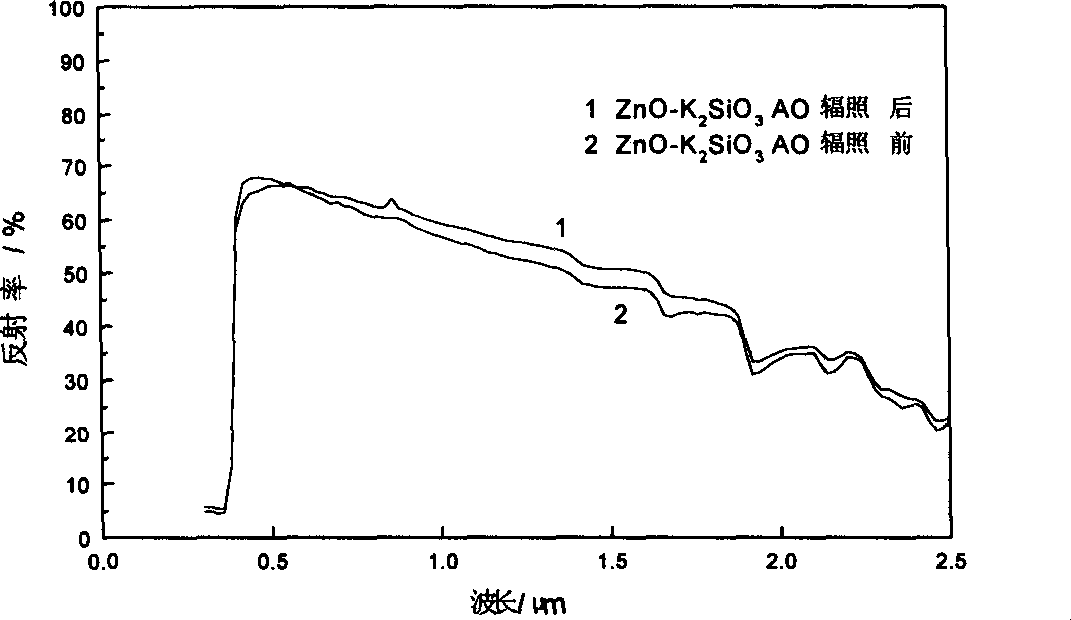Low sunlight absorptivity alumina-potassium silicate paintcoat for heat control and its preparing method
A technology of solar absorptivity and thermal control coating, applied in the direction of coating, etc., can solve the problems of lack of thermal control effect, accelerated corrosion and degradation of surface materials, poor adaptability of substrates, etc., and achieves a significant effect of resisting atomic oxygen erosion , low solar absorption rate, and stable space behavior
- Summary
- Abstract
- Description
- Claims
- Application Information
AI Technical Summary
Problems solved by technology
Method used
Image
Examples
Embodiment 1
[0032] Put 70g of potassium silicate and 200g of water into the mixing tank, start the mixer and stir evenly, then add 1g of stabilizer diethanolamine and stir evenly. Dilute the industrial sulfuric acid into 10% dilute sulfuric acid, slowly add it into the stirring tank, and control the pH within the range of 11-13 to obtain the acidic modified water glass base material. Sodium hexametaphosphate 0.5g is dissolved into 10% aqueous solution and dropped in the stirring tank, then drops into OP emulsifier 0.5g, defoamer tri-n-butyl phosphate 0.5g (purchased from Germany Bayer company, its product model is 5500) and 1 g of dispersant alkaryl polyether alcohol (purchased from Union carbide, namely 466 type dispersant) were stirred evenly. 10g of light calcium carbonate, 30g of heavy calcium carbonate, 10g of talc powder, 10g of mica powder and 140g of alumina powder were put into a tank for dispersion and ground by a ball mill to make a slurry. When in use, add phenylacrylic acid ...
Embodiment 2
[0034] Take 86g of potassium silicate and 200g of water and put them into the mixing tank, start the mixer and stir evenly, then add 1.5g of stabilizer diethanolamine and stir evenly. Dilute the industrial sulfuric acid into 10% dilute sulfuric acid, slowly add it into the stirring tank, and control the pH within the range of 11-13 to obtain the acidic modified water glass base material. Dissolve 1g of sodium hexametaphosphate into a 10% aqueous solution and put it into the stirring tank, then add 1g of OP emulsifier, 1g of 5500-type defoamer tri-n-butyl phosphate and 466-type dispersant of alkaryl polyether alcohol 2g and stir well. 20g of light calcium carbonate, 40g of heavy calcium carbonate, 16g of talc powder, 16g of mica powder and 168g of alumina powder were put into a tank for dispersion and ground by a ball mill to make a slurry. When in use, add phenylacrylic acid emulsion at a ratio of 1:0.6 (slurry: styrene-acrylic emulsion), and keep the mixed slurry in a fully ...
Embodiment 3
[0036]Take 105 g of potassium silicate and 200 g of water and put them into a mixing tank, start the mixer and stir evenly, then add 2 g of stabilizer diethanolamine and stir evenly. Dilute the industrial sulfuric acid into 10% dilute sulfuric acid, slowly add it into the stirring tank, and control the pH within the range of 11-13 to obtain the acidic modified water glass base material. Dissolve 1g of sodium hexametaphosphate into a 10% aqueous solution and put it into the stirring tank, then add 2g of OP emulsifier, 1g of 5500-type defoamer tri-n-butyl phosphate and 466-type dispersant of alkaryl polyether alcohol 2g and stir well. Various filler light calcium carbonate 40g, heavy calcium carbonate 60g, talcum powder 5g, mica powder 5g and
[0037] Alumina powder 200 is put into a tank for dispersion and ground by a ball mill to make a slurry. When in use, add phenylacrylic acid emulsion at a ratio of 1:0.9 (slurry: styrene-acrylic emulsion), and keep the mixed slurry in a ...
PUM
 Login to View More
Login to View More Abstract
Description
Claims
Application Information
 Login to View More
Login to View More - R&D
- Intellectual Property
- Life Sciences
- Materials
- Tech Scout
- Unparalleled Data Quality
- Higher Quality Content
- 60% Fewer Hallucinations
Browse by: Latest US Patents, China's latest patents, Technical Efficacy Thesaurus, Application Domain, Technology Topic, Popular Technical Reports.
© 2025 PatSnap. All rights reserved.Legal|Privacy policy|Modern Slavery Act Transparency Statement|Sitemap|About US| Contact US: help@patsnap.com



